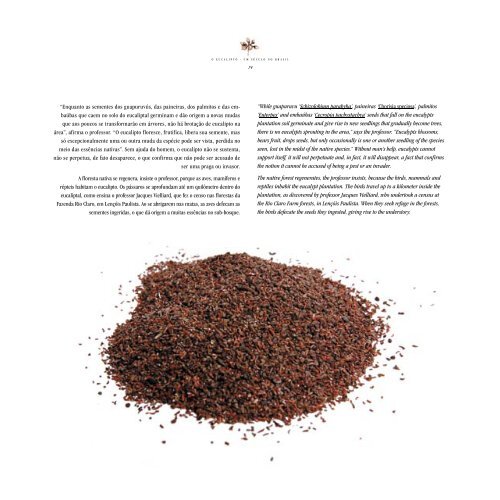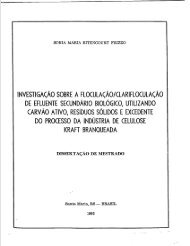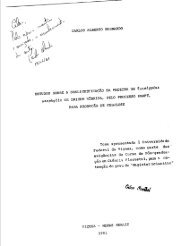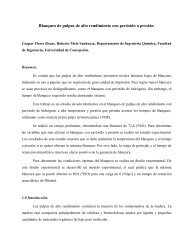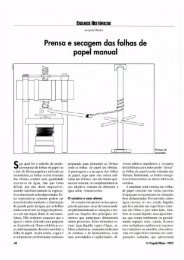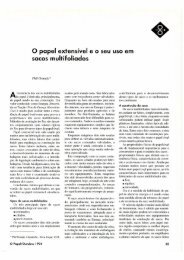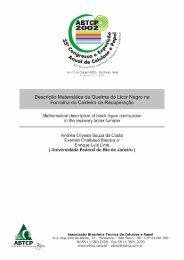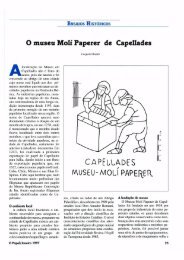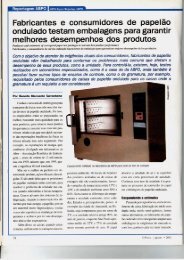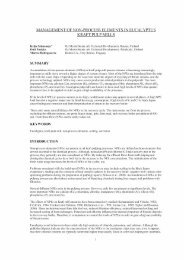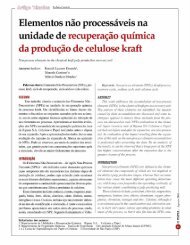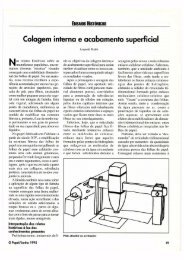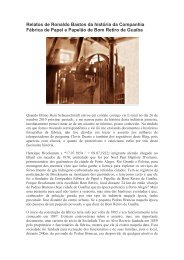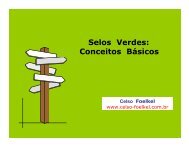O Eucalipto: um século no Brasil (The Eucalypt - Celso Foelkel
O Eucalipto: um século no Brasil (The Eucalypt - Celso Foelkel
O Eucalipto: um século no Brasil (The Eucalypt - Celso Foelkel
Create successful ePaper yourself
Turn your PDF publications into a flip-book with our unique Google optimized e-Paper software.
“Enquanto as sementes dos guapuruvús, das paineiras, dos palmitos e das embaúbas<br />
que caem <strong>no</strong> solo do eucaliptal germinam e dão origem a <strong>no</strong>vas mudas<br />
que aos poucos se transformarão em árvores, não há brotação de eucalipto na<br />
área”, afirma o professor. “O eucalipto floresce, frutifica, libera sua semente, mas<br />
só excepcionalmente <strong>um</strong>a ou outra muda da espécie pode ser vista, perdida <strong>no</strong><br />
meio das essências nativas”. Sem ajuda do homem, o eucalipto não se sustenta,<br />
não se perpetua, de fato desaparece, o que confirma que não pode ser acusado de<br />
ser <strong>um</strong>a praga ou invasor.<br />
A floresta nativa se regenera, insiste o professor, porque as aves, mamíferos e<br />
répteis habitam o eucalipto. Os pássaros se aprofundam até <strong>um</strong> quilômetro dentro do<br />
eucaliptal, como ensina o professor Jacques Vielliard, que fez o censo nas florestas da<br />
Fazenda Rio Claro, em Lençóis Paulista. Ao se abrigarem nas matas, as aves defecam as<br />
sementes ingeridas, o que dá origem a muitas essências <strong>no</strong> sub-bosque.<br />
O E U C A L I P T O - U M S É C U L O N O B R A S I L<br />
74<br />
“While guapuruvu ‘Schizolobi<strong>um</strong> parahyba’, paineiras ‘Chorisia speciosa’, palmitos<br />
‘Euterpes’ and embaúbas ‘Cecropia pachystachya’ seeds that fall on the eucalypts<br />
plantation soil germinate and give rise to new seedlings that gradually become trees,<br />
there is <strong>no</strong> eucalypts sprouting in the area,” says the professor. “<strong>Eucalypt</strong>s blossoms,<br />
bears fruit, drops seeds, but only occasionally is one or a<strong>no</strong>ther seedling of the species<br />
seen, lost in the midst of the native species.” Without man’s help, eucalypts can<strong>no</strong>t<br />
support itself, it will <strong>no</strong>t perpetuate and, in fact, it will disappear, a fact that confirms<br />
the <strong>no</strong>tion it can<strong>no</strong>t be accused of being a pest or an invader.<br />
<strong>The</strong> native forest regenerates, the professor insists, because the birds, mammals and<br />
reptiles inhabit the eucalypt plantation. <strong>The</strong> birds travel up to a kilometer inside the<br />
plantation, as discovered by professor Jacques Vielliard, who undertook a census at<br />
the Rio Claro Farm forests, in Lençóis Paulista. When they seek refuge in the forests,<br />
the birds defecate the seeds they ingested, giving rise to the understory.


